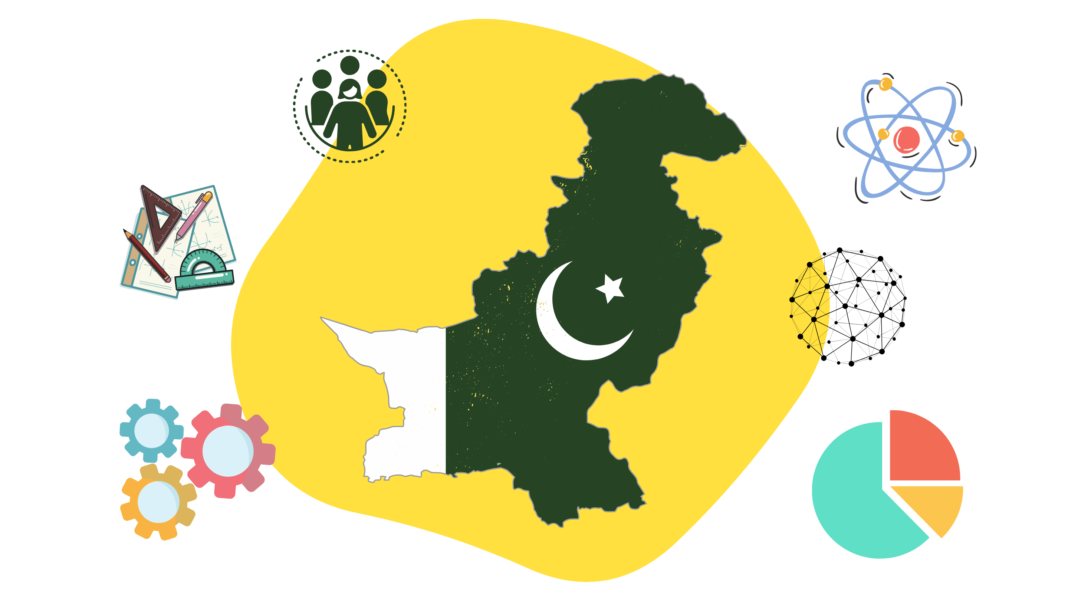In recent years, Science, Technology, Engineering, and Mathematics (STEM) education has been dramatically emphasized worldwide and demands the need for equity and inclusion. Although there is a global discourse on this need, it is particularly significant in countries like Pakistan.
The World Economic Forum explains the Diversity, Equity, and Inclusion (DEI) in STEM through an analogy that “Inviting everyone to the party is diversity, sharing DJ responsibility is inclusion, and having a large enough dance floor for everyone to groove on is equity.”
This highlights the need for active participation and equal opportunities for all (Urbina-Blanco et al., 2020).
Pakistan stands at the crossroads of innovation and inequality, where the future in STEM fields seems bright. Still, disparities of inequality, fewer opportunities, and access to these fields come in the way.
Barriers to Equity in STEM
While growing up and acknowledging the diversity of subjects and fields, I felt and comprehended the need for diversity and inclusion in STEM education. Students from background areas in Pakistan, not from the bigger cities, may face the dilemma of hardly knowing the options to opt for higher studies.
Most common perceptions are about being a doctor, engineer, or other arts subject, and the knowledge about the diversity of subjects, fields, and careers in STEM is minimal.
I believe this is due to the lack of career counseling, advisory student counselors, or facilities in those areas. If we talk about public schools, their curriculum, approach to learning, and teaching practices differ from those of private schools. This highlights the issues in equity, inclusion, access, and diversity of STEM education for every such student.
Pakistan, like many other countries, faces various issues of gender inequality, regional or ethnic differences, and socioeconomic distinctions that impact access and inclusion in the STEM fields.
Particularly if we talk about women’s rights and education in Pakistan, they face many challenges, including cultural or social barriers, lack of support, and access to opportunities. This lack of gender and racial equality has been under study for more than four and a half decades, according to the National Center for Science and Engineering Statistics (NCSES) (Hamrick, 2021).
Although there is an increased ratio of undergraduate women in science fields, their number in computer science, engineering, and technology needs to be improved (Fry et al., 2021). Due to the ethnic differences, they are mainly in number in these high-earning STEM occupations (Hamrick, 2021).

The Pew Research Center is a Washington-based nonprofit think tank that informs the public about the issues and trends shaping our world. It reports, “Despite the continuous efforts to increase diversity in STEM education, the current trends in the attainment of degrees in STEM are unlikely to close or narrow down all these gaps” (Fry et al., 2021).
Additionally, students from minority backgrounds and marginalized areas have also been primarily excluded and face issues to fully engage in STEM education and careers. Many studies highlight that the climate of higher education STEM programs is not welcoming for these kinds of students.
The Chilly Climate Theory
The “chilly climate theory” states that minority students experience discrimination in their college lives, in every aspect, including the interactions with their fellows, faculty, and administrators, due to a chilly culture in educational institutions that fosters discrimination and biases towards these students (Bottia et al., 2021).
This theory also highlights women’s negative experiences in higher education, such as speaking less or being hesitant during STEM classes. It highlights the chilly climate as racist and sexist in higher education (Bottia et al., 2021).
Another reason is that these minority students often lack sufficient academic preparation to adapt and pursue STEM fields and thus withdraw from them. One of the possible theories is that they might exit due to their limited knowledge or interest in these subjects, which is called deficit thinking.
However, anti-deficit theory highlights the disparity of educational institutions in preparing students inadequately for their further academic levels (Palid et al., 2023).
Approaches for Equity and Inclusion in STEM
As the need for STEM education evolves with time, the need for specialized and focused workforce also increases essentially, but unfortunately, not everyone has equal access and opportunity. There is a need to understand the significance of an inclusive workforce in getting scientific advancements and innovation. For that purpose, the accessibility of the population is equally important.
“If this nation wants to be a competitive leader in STEM, it has to revitalize its vision of what it needs to do, particularly in the public schools where most Black and brown people are, about producing the human and physical infrastructure to teach STEM,” says Joseph L. Graves Jr., professor of biological sciences at North Carolina Agricultural and Technical State University (O’Rourke, 2021).
What needs to be done?
The struggle to include diversity in STEM fields required continuous research into diversity-focused interventions. Fostering equity and inclusion involves several approaches.
- The science curriculum must foster mathematical reasoning, scientific literacy, and a deep practical understanding of the content rather than just learning about the procedures or definitions in the text (Harrison et al., 2020). The studies focus on enhancing students’ empowerment to identify themselves as engineers, biologists, etc., particularly in identifying the fields of their interest.
- A focus on STEM educators’ training to highlight the significance of equity in the educational process. It includes supporting all the students equally, not favoring certain groups, and adopting approaches that enhance their interests and participation in STEM fields like practical demonstrations, study circles, etc.
- The educators should train about the integration of STEM education in all disciplines. This may include using technology-based tools like study casts and projectors and incorporating arts and reading. (Harrison et al., 2020).
- There is a dire need for a few innovative approaches to fill the opportunity gaps for students who face cultural, social, or financial barriers (Ladson-Billings, 2013). This may include conducting free summer camps, assistive technology, etc.
- Authorities should work to enhance ongoing professional development and training programs for educators, incorporating diversity and anti-biased training for professionals, giving equal representation to individuals from marginalized areas in STEM careers by high recruiting (Urbina-Blanco et al., 2020), using technology for education all the public and private sector schools, helping the students to identify their careers, etc.
- There is a need to provide appropriate infrastructure, educational resources, scholarships, and financial aid to students from underprivileged areas and minority groups (Palid et al., 2023). This practice may help bridge the socioeconomic gaps in our society.
- There should be more initiatives to break gender stereotypes and assist women’s education and career opportunities.
Overall, by creating an inclusive environment where everyone feels valued, respected, and supported, Pakistan can unlock the full potential of its diversified, talented population and promote innovation and excellence. It paves the way for an inclusive and accessible STEM landscape for national development.
References
- Bottia, M. C., Mickelson, R. A., Jamil, C., Moniz, K., & Barry, L. (2021). Factors associated with college STEM participation of racially minoritized students: A synthesis research. Review of Educational Research, 91(4), 614–648.
- Fry, R., Kennedy, B., & Funk, C. (2021). STEM Jobs See Uneven Progress in Increasing Gender, Racial and Ethnic Diversity.
- Hamrick, K. (2021). Women, minorities, and persons with disabilities in science and engineering. National Science Foundation Retrieved from https://ncses.nsf.gov/pubs/nsf21321/report
- Harrison, L., Hurd, E., & Brinegar, K. (2020). Equity and access to STEM education. Middle School Journal, 51(3), 2–3. https://doi.org/10.1080/00940771.2020.1735847
- Ladson-Billings, G. (2013). Lack of achievement or loss of opportunity. Closing the opportunity gap: What America must do to give every child an even chance, 11, 11-22.
- O’Rourke, B. (2021). Increasing access and opportunity is crucial, say experts. Harvard Gazette.
- Palid, O., Cashdollar, S., Deangelo, S., Chu, C., & Bates, M. (2023). Inclusion in practice: A systematic review of diversity-focused STEM programming in the United States. International Journal of STEM Education, 10(1), 2.
- Urbina-Blanco, C. A., Jilani, S. Z., & Speight, I. R. (2020, August 17). Science is everybody’s party: 6 ways to support diversity and inclusion in STEM. World Economic Forum. https://www.weforum.org/agenda/2020/08/science-stem-support-inclusion-diversity-equality/
More From the Author: Understanding ADHD: Exploring Symptoms, Causes, and Effective Treatment Strategies

Zaryab Imran is an MPhil student and enthusiastic young researcher at the Centre of Excellence in Molecular Biology, Punjab University. She graduated in Microbiology from Quaid-I-Azam University Islamabad. She’s a freelance writer passionate about life at the molecular level. She has recently joined team Scientia Pakistan.

